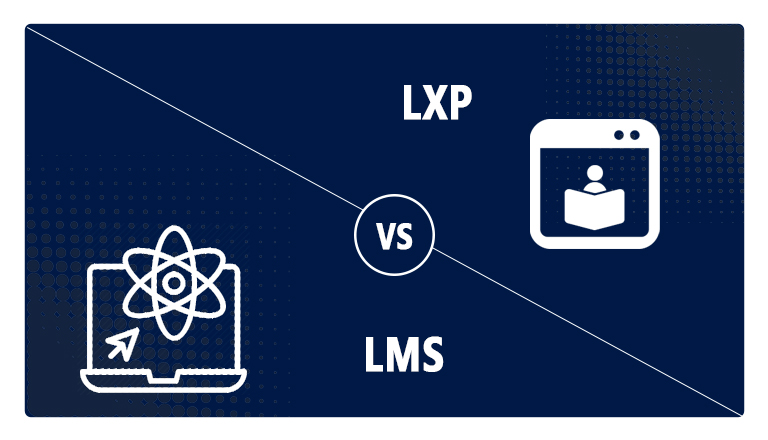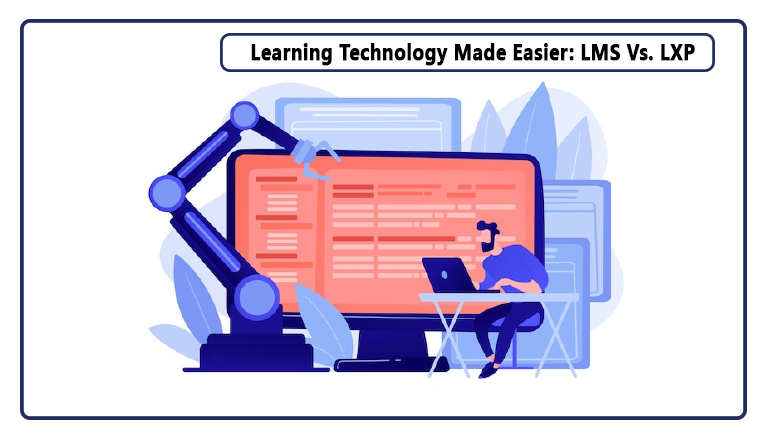If you work in the learning industry, you must have come across the terms LMS and LXP. While the term LMS has been in use in the L&D industry since 1990, LXP, on the other hand, is a relatively new term, surfacing only in 2012. But what is the difference between the two? And which is better for your organization?
In this blog post, we’ll be exploring just that and presenting you with a shortlist of the top commercially-available applications of both.

What is the main difference between an LMS & an LXP?
An LMS is a learning management system focused primarily on allowing organizations to upload and assign learning courses to employees. Learning management systems allow organizations, also, to track the completion of courses. An LXP, on the other hand, is a learning experience platform. As the name implies, it is less focused on ‘managing’ learning, and more focused on upgrading the users’ experience of learning. LXPs provide learners with more flexibility allowing them to explore learning options and make learning decisions for themselves, all the way while collaborating and engaging with other learners.
Key Differences between LMSs & LXPs
There are main differences between LMSs and LXPs, which make each have its own distinctive applications.
1. Who’s in Control?
LMSs usually give more control to L&D admins, enabling them to assign courses to learners, set completion dates, track completion, and generate completion reports. On the other hand, LXPs give more control to learners. In an LXP, learners can explore a wide array of content in several formats, select the ones they like, and may, even, curate their own learning paths. In an LXP, the learner takes the wheel.
2. What type of learning courses are covered?
Although not a rule, LMSs have traditionally been used to deliver content that is more focused on mandatory or compliance training. Being administered by L&D admins, for the most part, who may not necessarily be fully familiar with the specific skillsets required for the individual roles in their companies.
LXPs, on the other hand, are more often used to drive reskilling and upskilling programs. Due to their excellent use of user data analytics, LXPs can create skill taxonomies for every role in any company and can make content recommendations for users, accordingly, based on their roles. Moreover, since most learning on an LXP is learner-initiated, most learners tend to focus their learning efforts on acquiring skills rather than checking company boxes.
3. What Type of Content is Featured?
An LMS usually features content in a SCORM format, which means that content is usually presented in very limited modalities since SCORM is by nature a rigid set of guidelines. Contrary to this, LXPs use an xAPI technology that allows content upload and curation from all different sources and modalities. In other words, in an LXP, learners can enjoy a wide array of content. They can hop from taking a micro-learning video to answering a quiz, then to reading a publicly-available blog post.
4. How is Data Analytics Used?
Both LMSs and LXPs provide powerful data-based solutions. An LMS provides powerful analytics regarding learning tracking and completion. LMSs are also powerful in assigning the right mandatory programs to each employee level in the company. LXPs, likewise, provide powerful analytics but center more on content rating, content use, and skill or competency rating per employee. An LXP, also, uses learner data, coupled with the power of artificial intelligence (AI), to provide more accurate content recommendations, personalized paths, and, most importantly, company-wide and individual-level skill mapping and level reports.
5. What Learning Methodologies are Utilized?
LMSs are suitable for structured, formal learning, that are formally and expert-generated. LXPs, on the other hand, are more suitable for self-learning, supported by social learning. This is because LXPs enable user-generated content and enable social collaboration through forums, content sharing, and posting of likes and comments on consumed content. LXPs are also ideal for microlearning formats, making them perfect for ‘learning in the flow of work’.
So which is better: an LMS or an LXP?
There is no option that is fundamentally better than the other. It all boils down to your organizational needs. If your L&D objectives are focused on mandatory and compliance training and you would prefer a more centralized approach, an LMS would do the job for you. If you are building a decentralized learning strategy where employees take ownership of their own learning and you are more geared towards skilling programs, then an LXP could be the better choice for you.
Needless to say that you can, definitely, have both an LMS and an LXP since they are, inherently, integrative, not mutually exclusive. In fact, some of the top companies in the world opt for such integrated solutions.
Our Top LMS and LXP Partners in the Market
If you work in L&D, you probably know that the options are huge. So, to make things easy, we have compiled a shortlist of the top LMSs and LXPs for you.
Cornerstone OnDemand
Founded in 1999, Cornerstone OnDemand, popularly known as CSOD, is one of the world’s leading LMS & LXP providers.
- LMS: The company’s LMS is a unified platform that helps you govern, assign, automate, and track all required training. With Cornerstone LMS, you can boost productivity with version management and seamless inline content workflows. The LMS also features its own application, enabling employees to learn anywhere anytime.
- LXP: CSOD’s LXP EdCast, is an AI-powered Learning Experience Platform (LXP) that helps you democratize learning and skill-building for your organization by giving employees access to hyper-personalized expert content in the flow of work. With EdCast, you can embed learning in the moment of need inside the apps you already use in your organization.
Skillsoft Percipio
With more than 36 million learners and counting, Skillsoft democratizes learning through an intelligent learning experience and a customized, learner-centric approach to skills development with resources for Leadership Development, Business Skills, Technology & Development, Digital Transformation, and Compliance.
Their flagship product, Percipio, is an LXP that features curated, immersive, and engaging skill-building content delivered when and where you need it — almost like the Netflix of L&D!
Totara
Dubbed a talent experience platform, Totara features an LMS, an LXP, and a talent management platform, that, when combined, unleash a world of amazing data-based opportunities for employee growth. As such, Totara combines skills and performance development to create lasting employee success and personalized learning paths.
Totara offers three main products:
- Totara Learn– an LMS that enables you to assign and monitor learning progress
- Totara Engage– an LXP that provides formal and social learning environments, uniquely branded and personalized to enable a distinct user experience for different departments, teams, and organizations.
- Totara Perform– a talent management system that enables you to set performance objectives, track employee performance, identify your company’s top talent, and create succession plans.
Open LMS
As the name implies, Open LMS is an open-source LMS designed to deliver an effective and engaging learning experience. As the largest commercial Moodle provider in the world, they help organizations deliver great learning experiences without complexities that allow administrators and L&D managers to focus on creating a quality, robust learning culture.
Get the Solution that Works for You
This was the difference between LMSs and LXPs in a nutshell. If you’re interested in knowing more about these solutions or would like to view a live demo, you can contact us at enquiries@xpertlearning.com.

